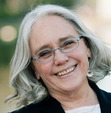Edith Maxwell's Blog, page 227
July 25, 2016
Feeling Reflective
Or, A Letter to My Younger Self
Edith here, yes, feeling reflective toward the end of another New England July.
We’re in full summer here. Our glorious short-lived tomatoes are ripe and dripping deliciousness. Corn is starting to come in. The blueberries have been fabulous. The beach is primo. And it’s been nice and hot, as summer is supposed to be. Hey, remember, it’s going to snow soon! I try to soak it all up, all the flavors and aromas and sensations, while summer lasts.

John David and Allan Hutchison-Maxwell
Still, the days are getting shorter already, and I’m getting old enough that it makes me think about my own days inevitably getting shorter. I’m still thriving, don’t get me wrong, and just recently have even managed to corral a couple of runaway aspects of my health. All good. And I have two awesome, healthy, handsome, generous, fun, self-supporting sons (ages 30 and 27), which makes me the happiest mom in the world.
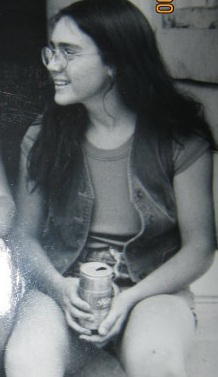
At Indiana University, 1980
But all this makes me think of what I might want to tell my twenty-something self if I had the chance. What might be better about my life now if I’d done a few things differently back then?
So here goes. Dear Edith (or Edie, as I was known for most of my twenties),
Please consider not lifting the heaviest thing you can. You’re little. You don’t have to prove anything, and it’s going to be hard on your joints. Also, use the gears on your ten-speed bicycle. You don’t have to use the hardest gear at all times, especially going up hills.
Reflect on what you say to your elders. You didn’t invent these freethinking new ideas, and your parents and other older people might have also thought them, both back in the day and now. Go easy on them; don’t be a know-it-all.
Remember those short stories you used to write in elementary school, and the one titled “Viking Girl” you actually got paid for when you were nine? Try your hand at fiction again before you turn sixty. You might find you’re good at it.
You could think about heeding the advice Dr. Mackler [battleax old-style female doctor]
gave you when you were sixteen about staying out of the sun, instead of going 100-percent tanning at the quarry or roasting in your bikini at the beach. You’re a pale-face Celt, girl, and you don’t have the kind of skin that can tolerate burns or even tans. You don’t want age spots and pre-cancerous lesions later on – do you?
But otherwise yo u’re doing fine. Keep living life to the fullest, keep telling those you love you love them (you’re good at that), keep following your dreams, wherever they lead you. It’s all going to be material one day!
u’re doing fine. Keep living life to the fullest, keep telling those you love you love them (you’re good at that), keep following your dreams, wherever they lead you. It’s all going to be material one day!
Love, your Older Self
Readers: What would you tell your twenty-something self? Any regrets from those days? Anything you’re particularly proud of from that era of your life?
Filed under: Edith's posts, Uncategorized Tagged: letter to self, Life Lessons, skin cancer

July 22, 2016
What’s my brand? What does it matter? And a giveaway! by Daryl Wood Gerber
Hey all, Liz here – and today I’m happy to host the lovely and talented Daryl Wood Gerber. She doesn’t need much of an intro with this crowd – so take it away, Daryl!
 Branding oneself – what does that mean?
Branding oneself – what does that mean?
When the first Cheese Shop Mystery came out, I “branded” myself as the cheese lady. I did my research. I became knowledgeable. I had fun. Readers at conferences didn’t know my name, but they knew I was the cheese lady.
When the first Cookbook Nook Mystery came out, I re-branded myself as a culinary or foodie mystery author. It was a no-brainer. I know food. I love recipes. The Cookbook Nook Mysteries are set in a cookbook shop and feature food. Plus I was already posting 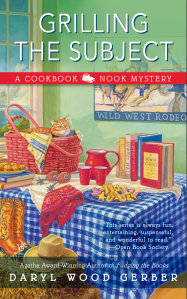 recipes and photographs on Mystery Lovers Kitchen.
recipes and photographs on Mystery Lovers Kitchen.
However, when I decided to publish a stand-alone suspense novel, I hit a wall. How was I supposed to brand myself so that readers knew what they were getting? Would my readers feel that I had betrayed them? What about the food and the recipes and the small town flavors they had come to expect from me?
As I was redesigning my website, I came up with some food terms that I thought might help define my work: Tasty ~ Zesty ~ Dangerous.
Tasty and zesty are pretty self-explanatory. Why dangerous? Think of it like three-alarm-chili dangerous. At first it was a designation for some of my short stories. They are not all cozy. Then I realized that dangerous could also work for my future suspense novels.
However, I got to wondering if that was the brand that would help my fans feel comfortable reaching for my other genre titles on the shelves? I asked myself: Why have my readers truly enjoyed my books? It can’t be just because of the food element. I’m not a celebrity chef.
Then it hit me. My readers like that I write about family. The protagonists in all my books are closely bonded to family. They are loyal. They follow their hearts. Not all families are built the same way, of course. In the Cheese Shop series, Charlotte’s family includes her darling grandparents, her cousin and his daughters, and her good friends Delilah and Meredith. In the Cookbook Nook series, Jenna’s family includes her dad and aunt but also her good friends, Bailey and Katie. [Just between you, me, and the lamppost, I think she would like to make Rhett family sometime soon, too.] No matter what, the protagonist’s devotion to protecting those she loves is vital to her—just like it is to me.
So, though all my novels might be tasty, zesty, or dangerous, the theme is always family.
For example:
 In Girl on the Run, when Chessa wakes up beside the body of her husband, nauseous and confused, unable to explain to the sheriff why her princess costume is covered in blood, she runs. Over the course of the novel, she must delve into the truth about her husband and her family.
In Girl on the Run, when Chessa wakes up beside the body of her husband, nauseous and confused, unable to explain to the sheriff why her princess costume is covered in blood, she runs. Over the course of the novel, she must delve into the truth about her husband and her family.
In Grilling the Subject, Jenna’s father becomes the suspect in the murder of one of his neighbors. The woman and he have been at odds over property rights. Jenna won’t sit back and let him go to jail. She has to prove him innocent.
Now, a question you might ask: can my cozy readers read my suspense even though they are categorized as dangerous? Yes. I still avoid using bad language. I do not write explicit sex or violence. The pace is faster, the ante greater, but the theme—family—is the same.
Some might wonder whether writing in multiple genres means I’m scattered. I don’t think so. I’m creative. I have lots of ideas. There are plenty of authors who write for more than one audience. It can be done.
What’s next for me? I’m going to publish another suspense. It will come out in November. I’m going to continue writing more cozy mysteries, too.
No matter what, each novel—whether tasty, zesty, or dangerous—will focus on family because family matters. That’s my brand and I’m sticking to it!
Daryl, thanks for visiting!
Readers, leave a comment for Daryl for a chance to win any of her published books in print or e-book format: Cheese Shop Mysteries (1-7), Cookbook Nook Mysteries (1-4), or Girl on the Run.
Agatha Award-winning and nationally bestselling author DARYL WOOD GERBER ventures into the world of suspense with her gripping debut novel, GIRL ON THE RUN. Daryl also writes the bestselling Cookbook Nook Mysteries. AsAVERY AAMES, she pens the bestselling Cheese Shop Mysteries. Fun tidbit: as an actress, Daryl appeared in “Murder, She Wrote”. In addition, she has jumped out of a perfectly good airplane and hitchhiked around Ireland by herself. She absolutely adores Lake Tahoe, where GIRL ON THE RUN is set, and she has a frisky Goldendoodle named Sparky. Visit Daryl at www.darylwoodgerber.com.
Twitter: @darylwoodgerber
Facebook: www.facebook.com/darylwoodgerber
Website: www.darylwoodgerber.com
Filed under: Guest posts Tagged: branding, Cookbook Nook Mysteries, Daryl Wood Gerber, family, Girl on the Run, Grilling the Subject

July 21, 2016
Welcome Reviewer Extraordinaire, John Valeri!
Hey friends, Liz here. Today I have the pleasure of introducing one of my favorite pals – and hardcore book reviewer – John Valeri. John and I met the first time I attended the Seascape Writer’s Retreat (jeez, was that in 2007? How can that be??) and I was immediately captivated by his love for books, his contagious laugh and his obsession with everything Scream . Today, John has made quite a name for himself in the world of book reviews – a name that no doubt will continue to grow in popularity as he moves into a proverbial new chapter. He’s here today to tell us all about that chapter.
Take it away, John!
 On June 25th, my Hartford Books Examiner (HBE) Facebook page reached its 1,000th like.
On June 25th, my Hartford Books Examiner (HBE) Facebook page reached its 1,000th like.
On the 28th, I was at R.J. Julia—Connecticut’s illustrious indie bookstore—when a patron shared with me that her attendance at three recent events was a direct result of learning about them through my column (the ultimate validation for those of us who wonder if anybody’s actually reading our stuff).
Three days later, scrolling through Facebook, I learned that the forces behind Examiner.com had pulled the proverbial plug—and that my seven-and-a-half year reign as HBE had come to an unceremonious end. (How cliché that I’d learn of this through social media, right?)
A brief moment of panic.
Not because I’d have to find some new job to replace the $12 of income they paid me every month (that’s an approximation, and probably a generous one) but because I feared losing my place in the community that I so adore. So much of my identity had been wrapped up in a title. What would I do with that being taken away?
I had been granted intimate access to hundreds of authors, invited to moderate panels and one-on-one discussions at prestigious events, received complimentary books by the dozen, and found pull quotes of mine featured on, and in, books by the likes of James Patterson, Wally Lamb, Shania Twain, Mary Higgins Clark, and Debbie Macomber. Even Marcia Clark—yes, that Marcia Clark—who had been a hero of mine since the age of twelve.
It seemed I had a lot to lose.
But then? My paranoia was replaced by an overwhelming sense of … freedom.
While I am deeply appreciative of Examiner.com for providing me a forum, I had increasing frustrations about their poor compensation and maddeningly inconsistent editorial feedback. Still, I had hesitated to part ways because so many people knew me as an extension of that platform.
And then I realized something: Everything that HBE had become was my doing. I was the one who committed myself to writing multiple articles per week at the cost of sanity and sleep. I was the one who tirelessly recruited guest authors to appear virtually before they knew what Examiner.com was (but would later be so inundated with requests that I couldn’t keep up). I was the one who wrote the content that had been pulled for use in books and web sites and any number of other literary things.
Sadly, I also found that my voice, my very personality—which had been absolutely integral in branding HBE—was being silenced by nameless, faceless cyber superiors who thought they knew my readers better than I did. I firmly believe that professional and personable can coexist.
When I announced my liberation on Facebook, I was met with an overwhelming outpouring of support and encouragement from authors, bloggers, booksellers, readers, and other friends who I’d connected with since 2009. It soon became evident that my place among them was never in jeopardy. And if there was a common sentiment, it was this: Start your own site.
So I did.
Actually, my wife did. Chelsey—who is far better at all things requiring a modicum of tech savvy—immediately set about building my own personal web page. (She probably suspected that my initial elation at finding myself untethered would soon turn to abject terror.) On July 4th, I declared my creative independence with the unveiling of www.johnbvaleri.com, a virtual home where I can continue pushing my bookish agenda with reckless abandon.
While this new endeavor has only just begun, I’m excited knowing that the next chapter is mine alone to write.
John, so excited that you’ll be starting your own site. Best of luck to you – and we’re all here to support you! Readers, leave John a comment and wish him well!
Filed under: Guest posts Tagged: book reviews, Books, fiction, John Valeri, Reading

July 20, 2016
Myth Busting Part II – Word Count
Last week, we started tackling the (many) myths and rules that fly around about writing and the writing process, and busting them.
This week, we’re talking word count. Some say you have to decide on a word count to hit each day (or week) in order to declare success. So what do you think, Wickeds? Do you have a word count goal? Do you feel like you need one in order to feel like you’ve had a productive day/week?
Edith: I do use word count to push myself when I’m writing a first draft. I know some people don’t, and I’m not saying anybody else has to! But for me, to set a word count goal of 1500 or even 2000 words for a day keeps me in my seat, which is where the words flow onto the page. I started the first draft of Quaker Midwife #3 at the start of June, and I finished it at a too-short 56000 words last week on the 13th – which is fast even for me. And I accomplished that by setting word count goals.
Liz: Some kind of goal is helpful for me to stay on track, but it totally depends on where I am in the process. If I’m writing a first draft, I try to do a thousand words a day – but I’m also realistic enough to know during the week sometimes I won’t, so if I log a good number on the weekend instead, it’s ok. If I’m in the plotting phase, which I’m just trying out, maybe it’s 1-2 scenes a day, and then a few more on the weekend. And if I’m editing, I try to do a certain number of scenes, depending on how much work they need.
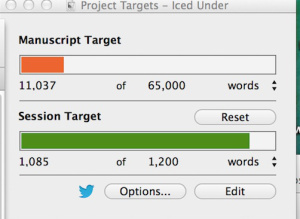 Barb: When I’m in first draft mode, I use word count to push myself. I leave the Scrivener project targets window visible at all times as a motivator. (“When I finish this, I can go for a swim.”) A good, comfortable day for me is 1200 words. For revisions, I have a number of scenes as a goal, or a number of pages. Often I’ll work on one day of the narrative.
Barb: When I’m in first draft mode, I use word count to push myself. I leave the Scrivener project targets window visible at all times as a motivator. (“When I finish this, I can go for a swim.”) A good, comfortable day for me is 1200 words. For revisions, I have a number of scenes as a goal, or a number of pages. Often I’ll work on one day of the narrative.
Sherry: Early in the process I do a steady 1000 to 1500 words a day. I usually cover the word count on the computer so I focus on writing instead of the number of words.
Julie: I love that Scrivener helps with goals and word counts. I am a plotter, so I try and write a scene at a time. Wish I could say I wrote a scene a day, but having a full time job makes that tough for me. But I try for 4-5 scenes a week. Average manuscript has 60-65 scenes. I would love to establish a 500-1000 words a day habit, but I have trouble enough keeping up with my steps.
Edith: FYI for our non-writer reader friends, 250-300 words makes a page, usually. You can translate our daily goals for yourself.
Readers: How do you keep track of project goals, whether at work or at home? Writers, does word count motivate you?
Filed under: Wicked Wednesday Tagged: Barbara Ross, Edith Maxwell, Jessie Crockett, Julianne Holmes, Liz Mugavero, Quaker Midwife Mysteries, Sherry Harris, Wicked Cozy Authors, word count

July 19, 2016
The Detective’s Daughter – The Summer Reading List
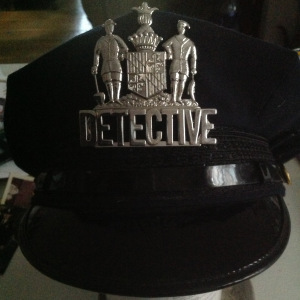
Kim in Baltimore surviving the heat.
What do Jaws, The Eye of the Needle, Where Are the Children, and Valley of the Dolls have in common? They are a few of the books I remember my mom reading when I was a child. Every day, whether she was sitting on the front steps or in the car waiting for Dad to come out of work, Mom was always reading a book.
Last summer, as I was moseying about in the East Village, I picked up a well-worn copy of Rosemary’s Baby in The Strand. By the next day I’d read it cover to cover. Rosemary’s Baby is one of my favorite movies and I remembered Mom reading the book years ago.
Each week we took a trip to the Enoch Pratt library where Mom would walk out with an armful of novels she’d have read long before our next visit. By the time I was fourteen we were both reading Mary Higgens Clark, Phyllis Whitney and Barbara Michaels.
Throughout the years I’ve read Gone With the Wind more times than I can count. I have Mom’s battered copy locked on the shelves of my desk. I take it out just to hold sometimes, remembering Mom sitting in her folding chair, with her cigarettes and iced tea at her side, flipping the pages of the latest book she’d borrowed.
Dad was not much of a reader other than the morning and Sunday editions of The Baltimore Sun. However, one week Mom checked out The Godfather from the library and before she had her iced tea poured and her cigarette lit, Dad was absorbed in the novel. It’s the only book Mom and I ever recall seeing Dad read.
I’ve thought often about the books Mom has read and decided this summer to make them my reading list. I could cross off Rosemary’s Baby and Gone With the Wind; they are books I will read time and again. It wasn’t hard to come up with titles, but I needed to keep it compact. There’s only so many weeks in summer! Here’s what I came up with: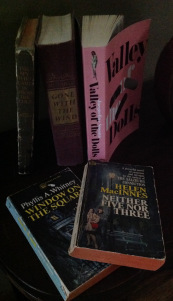
Valley of the Dolls by Jacqueline Susann
Jaws by Peter Benchley
The Stepford Wives by Ira Levin
The Eye of the Needle by Ken Follett
Neither Five Nor Three by Helen MacInnes
Window on the Square by Phyllis A. Whitney
The Godfather by Mario Puzo
The Spy Who Came in From the Cold by John le Carre
I’ve finished reading Valley of the Dolls and am well into the Phyllis Whitney book. I unfortunately began watching Mad Men the same time I was reading Dolls. It was depressing reading and seeing how little freedom and respect women were given. I don’t think I can bring myself to watch another episode of Mad Men!
As I’ve compiled these books and read through them I’ve thought about what these titles say about my mom. Why do we select the titles that we do? Why are some inclined to read only mystery while others enjoy the classics? Is the genre you prefer inherited or learned?
I spoke to Mom this morning and asked her why she chose certain books. “They seemed interesting,” she said. She wasn’t particularly aware if they were best sellers or if a movie deal was in the works, she just enjoyed reading. I think that’s the part I inherited.
Hope you’re enjoying your summer reading. Please share with us the titles of books you have read more than once and why.
Filed under: Beach Reads, Kimberly Kurth Gray, Reading, The Detective's Daughter, Uncategorized Tagged: Balitmore City, Baltimore, Barbara Michaels, beach reads, Books, bookstores, East Village, Enoch Pratt Library, Gone With the Wind, Helen MacInnes, Ira Levin, Jacqueline Susann, Jaws, John Le Carre, Ken Follett, libraries, Mad Men, Margaret Mitchell, Mario Puzo, Mary Higgins Clark, Mothers, Neither Five Nor Three, novels, Peter Benchley, Phyllis A. Whitney, Reading, Rosemary's Baby, summer, summer reading list, Sun Paper, The Eye of the Needle, The Godfather, The Spy Who Came in From the Cold, The Stepford Wives, The Strand, Valley of the Dolls, Where Are the Children, Window on the Square

July 18, 2016
A Day at the Beach
Hi friends, Liz here. Many of you probably know I am a total beach freak. I live for summer and harbor fantasies about living in a beachy place where summer is year round. Everything is better on the sand with the ocean in view.
But what does a day at the beach really entail? I know when I’m dreaming of my beach time,  I’m thinking of the moment when butt hits chair or feet hit water. But it’s not quite that simple. Here’s a look at the totality of a day at the beach, at least in my world.
I’m thinking of the moment when butt hits chair or feet hit water. But it’s not quite that simple. Here’s a look at the totality of a day at the beach, at least in my world.
The Day Before: Get excited. Find something healthy and yummy you can make and bring. Make said healthy yummy food. If really ambitious, gather chairs, umbrella and other paraphernalia for easy packing. Choose between Second Beach in Middletown, Rhode Island (2 hrs away) or Horseneck Beach, Westport, MA (1.5 hrs away). [Note: CT beaches aren’t our cuppa. The Sound is perfectly nice, but just not the same as the Atlantic.] Decide to leave at 9 a.m. to beat traffic, get parking, and claim a spot on the sand. Oh, and most important – choose books!
 The Day Of – 7 a.m. Wake up excited. Even cleaning up cat vomit isn’t so bad with the promise of the sand in between your toes. Try to find favorite towels, but they seem to be missing. Grab replacements. Review reading choices to make sure they’re still perfect for the day. Horseneck Beach bound!
The Day Of – 7 a.m. Wake up excited. Even cleaning up cat vomit isn’t so bad with the promise of the sand in between your toes. Try to find favorite towels, but they seem to be missing. Grab replacements. Review reading choices to make sure they’re still perfect for the day. Horseneck Beach bound!
8 a.m. Realize that regardless of the food planning, you’re still missing the major component of your lunch. Get dressed and go to the store.
8:30 a.m. The grocery store on a Saturday. Need I say more?
9 a.m. Finally back home, but need to make the rest of lunch. Departure time delayed.
9:30 a.m. Lunch main course is made, berries are washed, cooler is packed and car is loaded. Not too far behind. Oh, wait. One more pile of cat vomit discovered on the way out the door. Stop and clean.
10 a.m. On the road. Realize you left the exciting healthy snack made the day prior behind in the fridge. Oh, and the road to the beach is NOT littered with Starbucks, just Dunkin. Yuck. Coffee-less at the beach.
10:30 a.m. Traffic. Depending on which beach, could be worse.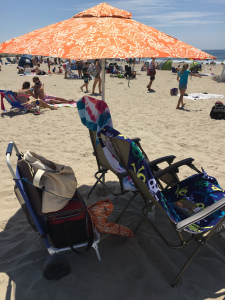
11:30 a.m. Arrive. Yay! Get into the (usually long) line to park. End up behind some woman who needs to have a 20-minute conversation with the attendant about something, probably that she doesn’t have the $15 fee. When she finally moves, you’re directed to the overflow lot.
11:35 a.m. Unload the car and try to figure out how to load all the things you “needed” onto the beach cart to get it to the beach.
11:45 a.m. Drag cart up the path, onto the sand and scan the area for the best spot, preferably not near small children or the dumpster. Unpack chairs, etc. Drop chair on toe. Realize the headrest to the chair fell off somewhere along the path. Retrace steps to retrieve. Find the bathroom.
Noon. Finally put butt in chair and sigh contentedly. Crack open book and dig in. After five minutes, realize you need water, which means unpacking the whole cooler to get to it.
12:30 p.m. The beach is filling up fast. A bunch of self-proclaimed still-drunk college kids camp out right in front of you. And keep multiplying. They’re still drinking. And the families with the little kids have come out too, and apparently the best spots are Right. Near. You. Eat what you remembered to bring for lunch and ignore it – you’re at the beach and life is good.
 1 p.m. Realize the sun has peeked around the umbrella without noticing and one shoulder/arm are totally burning. Adjust chair and keep reading. Because nothing matters when you’re on the beach.
1 p.m. Realize the sun has peeked around the umbrella without noticing and one shoulder/arm are totally burning. Adjust chair and keep reading. Because nothing matters when you’re on the beach.
1:15 p.m. Angry moms dragging kids through the sand because it’s super hot and their feet are burning. You could point out that they could just hand the kid their shoes, but whatever. You’re at the beach.
1:30 p.m. College students fighting. Stale Bud wafting through the beach air. Little kid next to us throwing shovels. A lady wearing a crazy fluorescent yellow wig and sequined bright pink bathing suit is trying to be a mermaid. Missed the photo op. Ah, the things you see on the beach.
2 p.m. Hit the water, finally. It’s beautiful! Reconnect with your inner mermaid. Hopefully there are sequins involved.
2:20 p.m. Back to the chair. Nap time, followed by more reading. The college students are alternating between fighting, sunburning and eating last night’s pizza. People are getting cranky. The lifeguards are trying to make the more adventurous swimmers come back to shore.
3 p.m. Time to pack up and leave, unfortunately. It’s this morning, in rewind – pack up the cart, lug it back to the car, try to leave some sand behind. One last glance at the water and you’re already wishing it was time to return. Until next beach day, time to go home and clean up more cat vomit.
Readers, tell us about your beach adventures!
Filed under: Liz's posts Tagged: beach, fun, sand, summer, sun

July 15, 2016
Welcome Back, Maureen Milliken!
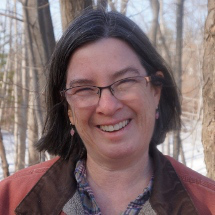 Hi. Barb here. Maine author Maureen Milliken visited us last year on the publication of her first mystery, Cold Hard News. Now she’s here to talk about the next book in the series, No News Is Bad News. I had a chance to read it over Fourth of July weekend and I loved it! The books are decidedly more Wicked than Cozy, but not hardcore. I put them in the category of amateur sleuth, traditional mystery.
Hi. Barb here. Maine author Maureen Milliken visited us last year on the publication of her first mystery, Cold Hard News. Now she’s here to talk about the next book in the series, No News Is Bad News. I had a chance to read it over Fourth of July weekend and I loved it! The books are decidedly more Wicked than Cozy, but not hardcore. I put them in the category of amateur sleuth, traditional mystery.
Barb: When I read your first book, Cold Hard News, I was impressed with the depth and complexity of your amateur sleuth, Bernie O’Dea, a small town newspaper owner/editor who struggles to manage her life, her business, and her adult ADHD. In No News Is Bad News, what I was most impressed with was the depth of the other characters, including your almost-co-protagonist, Police Chief Pete Novotny, the denizens of Bernie’s newsroom, and Bernie’s youngest brother, Sal. Following up on a discussion we’re having on Wicked Cozy Authors this week, how do you create characters? Do you do elaborate pre-work, interviews and bios, or let them develop on the page as you write, or some combination?
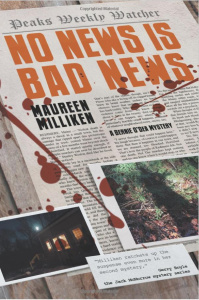 Maureen: I guess “some combination” is the best answer, since I don’t have a real process. With Bernie and Pete, I sat down at some point early while writing No News is Bad News and sketched out bios for them that were quite long, some of which I’ve adhered to and some not. I’ve never really looked at them since. They’re the two characters I’ve spent the most time developing. Bernie, as the protagonist, is a combination of the type of woman I wanted to have as a female protagonist (someone “normal,” who stumbles, rather than a super-woman), and also has many traits I have, since one of the points of writing, I believe, is to say something and she’s saying some of it for me.
Maureen: I guess “some combination” is the best answer, since I don’t have a real process. With Bernie and Pete, I sat down at some point early while writing No News is Bad News and sketched out bios for them that were quite long, some of which I’ve adhered to and some not. I’ve never really looked at them since. They’re the two characters I’ve spent the most time developing. Bernie, as the protagonist, is a combination of the type of woman I wanted to have as a female protagonist (someone “normal,” who stumbles, rather than a super-woman), and also has many traits I have, since one of the points of writing, I believe, is to say something and she’s saying some of it for me.
Pete started probably when I was 9 or 10 years old and started having crushes on TV characters and rewriting TV episodes in my head as I lay in bed (particularly with Pete on the Mod Squad but some others as well), but I also put a lot of thought into his development so he’d complement Bernie, but also be a strong character in his own right.
Other characters in the book, like Sal, sprung out of my head and developed on the page, though once they started developing, I’d give a lot of thought to who they are, how they’d behave, speak, etc. Since I have five siblings, I felt I could draw the relationship between Sal and Bernie accurately, but I also don’t have a brother like Sal, so had to consider him in detail as I wrote. One quick story: I used to be a high school track official and at one meet, there was a girl in the 3,200 (two-mile) race way, way behind the others, who finished while she still had a lap or two to go. Her little brother, still in his Catholic school uniform, with his little windbreaker in his hand, about 10 years old, starting running next to her on the infield. I’ll never forget that scene. It’s not in my book, but that’s what I was thinking of when I first started writing Sal. I don’t want my characters to be cardboard cutouts, so once they arrive, I try to delve into them a little more. A lot of this happens in my head and on the page, though I realize with the third book germinating, I need to get a lot of it down in a “series bible” so that I’m consistent and can also develop them further.
Barb: No News Is Bad News weaves together a complex story across three recent timelines, 2003, 2007 and 2009. However did you plot out this book? Did you have a vision for the forward story in each timeline separately, or write it as the books flows or what?
Maureen: Good question! What actually happened is that several years ago, I began the book as the story of Bernie’s brother Sal’s appearance and the plot that develops from that. I put that aside as I worked on Cold Hard News revisions. When I went back to writing the second book after I found a publisher for Cold Hard News, I found the plot, or what little I’d developed of it, didn’t motivate me as much as it had before. At the same time, I started getting excited about a possible prequel to CHN involving Pete’s case and how he ended up in Redimere. The idea had been sparked by a documentary “The Imposter,” that I’d watched that winter about a guy who pretended he was a missing kid and the the missing kid’s family oddly went along with it. So that was exciting me and beginning to form as a story in my head. But part of me was really disappointed, as I knew readers would be, too, that we weren’t going forward with Bernie and Pete’s relationship, which to me is a big part of the books. Then one day when I was in the shower, it hit me: Cold Hard News sequel, but with flashbacks! Why hadn’t I seen it before? It would be so easy.
Of course, it wasn’t. I see it really as two story lines, since 2003 is one chapter with some serious implications later in the book. I ended up writing the 2003-2007 part as one story, then the “actual book” as another. But I also had to make a lot of decisions about what to reveal, when, in the earlier plot in order to keep the suspense and surprises in the later one moving along, as well as how people in 2009 would talk about what had happened in 2007 and what would be revealed. So there was a lot of moving scenes around as well as reworking the writing once I merged the two story lines together.
In the end, the main goal was to try to make the writing as clear as possible, tell the story and be entertaining, but also raise questions that would intrigue rather than frustrate, and have faith that readers would go along with it, have the smarts to follow it (which of course, they do) and in the end the story would be richer for it all.
Barb: As a resident of a small Maine town, I loved the way this book focused the dump (or more politely, transfer facility). Every small town resident knows that while the grocery store, post office and churches all have a claim to be community centers, the real action is at the dump. What inspired you to make the dump the centerpiece of this story?

The dump
Maureen: Well, ha ha. There are a lot of things that come into play here. One is, like Bernie, I started obsessing about my prescription bottles going into the recycling and started thinking, as a mystery writer, what would happen if some enterprising dump worker started looking at addresses. I also became obsessed with the garbage hopper at my local dump — it really is fascinating to watch it crush and compress all that trash — and the possibilities there, and had to put it in a book. Like you point out, the dump is the center of all activity in a small town — at mine politicians campaign there, Girl Scouts sell cookies, you name it. So it had to be in the book.
So all that was already going on with me. Then one day last summer, when I went to dump my garbage, it was closed because someone (from away, of course) had backed his pickup truck into the hopper. I talked my way in so I could get some info for the newspaper, then I was given the bum’s rush by a very condescending, fairly rude transfer station manager who didn’t understand freedom of press access. On top of it, the poor kid at the gate who’d let me in and who became the physical model for Moses Mosher in my book, got thoroughly scolded for letting me in, something I’m not ashamed to say I watched with interest. Immediately, the dump’s role in my book expanded, as did the manager, though the one in the book bears no resemblance to the one in my town and the pickup truck story never made it into the book.
Barb: In No News Is Bad News, you bring your protagonist Bernie to a new level, showing and not telling us what the jangle inside her head caused by the ADHD does to mental processes, her confidence, her judgment and her life. When Cold Hard News came out, you wrote in your post here about how self-conscious you were about giving your heroine the same condition you were managing and how you braced for people’s reactions. A year later, what has the reaction to been Bernie’s ADHD? How do you feel about having outed yourself?
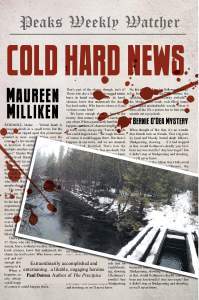 Maureen: I have no regrets about outing myself. There’s been little, if no, reaction to the ADHD angle, which I’m kind of surprised by. I’m not sure if it’s because it’s just not a huge deal and everyone is going with the flow, or if it makes people uncomfortable and/or is looked at as a gimmick.
Maureen: I have no regrets about outing myself. There’s been little, if no, reaction to the ADHD angle, which I’m kind of surprised by. I’m not sure if it’s because it’s just not a huge deal and everyone is going with the flow, or if it makes people uncomfortable and/or is looked at as a gimmick.
A little background: I was diagnosed with ADHD the same week I thought I was “finished” with Cold Hard News. While it explained SO MUCH, not only about me, but about Bernie, it took another year or so before I did a revision of the book that officially gave it to Bernie, too. My resistance to putting it in the first book was because, as I said, I didn’t want to tell the world I had it, and also I didn’t want it to feel like a gimmick or superficial “flaw” for a character. I felt good about it ultimately, because it gave me an opportunity to say a lot about a disorder that is really misunderstood and also overlooked in adults. One big thing is how many of us my age and older weren’t diagnosed as kids, we were just “bad kids.” It has a huge impact on people who grow up being told that. It also explains behavior that is considered not socially acceptable: talkativeness, loudness, interrupting, ditziness, poor organization skills, among other things. And it’s a reality that people would rather just wish people would stop acting like that, and believing they could if they want to, than having compassion for those of us who are different and realizing that stuff really isn’t so horrible in the big scheme of things.
After a particularly trying day at work, I came home to write and added a passage to the book where someone complained to Pete about how annoying Bernie was and Pete stuck up for her, though he was a little annoyed with her himself at that time. I feel everyone with challenges needs someone to do that for them. It doesn’t really happen much in real life, though. I feel like having ADHD and having to endure (and this still happens) lectures about the things that make me annoying to be around, have made me (and Bernie) more empathetic. In the end, everyone has something that makes their life a struggle. Pete has PTSD, and I’m not sure he and Bernie have yet discussed their issues, but I can see that happening in Book 3. In general, I try to have compassion for characters in my book who are out of the mainstream, who may be treated superficially by the world around them, but are human beings who deserve understanding. It’s easier in books than in real life — I don’t want people to think I’m a hypocrite. It’s something I try to remember daily, but don’t always succeed. Bernie, too. So whether it’s ADHD, PTSD, a mental illness or intellectual disability, I try to create characters who are more than their “flaw.”
Barb: Compassion for our characters. Great writing advice. What are you working on now?
Maureen: Book 3! Yet to be named, but with News in the title, of course. I can’t say much about it — not because I’m secretive (you KNOW by now I’m not), but because it’s forming and gelling in my brain. I’ll say this: It takes place six or seven months after NNBN ends. Bernie and Pete are still feeling their way with each other. It’ll involve a missing hiker, a fugitive hiding in the woods and some more woods dwellers (because we have had major stories at the newspaper I’m city editor of recently involving all those things and the plot started forming itself despite any objections I may have had).
I’m also appearing at author events and signing, and in cyperspace, including Facebook, Twitter, my webpage and with emailed web updates, since that’s how we writers roll these days. And on blogs like this, of course!
Thanks for the opportunity, Barb, and Wicked Cozies. I love talking about writing, both with writers and readers. Anyone who has questions or wants to elaborate on the discussion is welcome to track me down through my website, maureenmilliken.com, or my author page on Facebook, Maureen Milliken mysteries.
Thanks for coming, Maureen!
Readers: How do you feel about multiple timelines and flashbacks in books? Personally, I love them. I am a huge fan of non-linear narratives. But I also think they require huge skill to pull off.
Save
Save
Save
Save
Save
Filed under: Guest posts Tagged: Adult ADHD, Bernie O'Dea, Cold Hard News, No New is Bad News, town dump, transfer facility

July 14, 2016
The Five Definitions of Scene
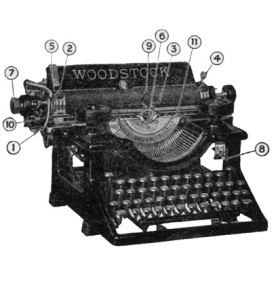
Hi. Kim Gray here. Today we welcome Stuart Horwitz the founder and principal of Book Architecture. He is the author of three books, the latest being Finish Your Book in Three Drafts: How to Write a Book, Revise a Book, and Complete a Book While You Still Love It. He joins us today to discuss The Five Definitions of Scene.
Take it away, Stuart!

What’s the big deal about scene? Well, as a group of self-contained passages within your narrative, they are nothing less than the building blocks of your work. Finding the places where your scenes break and separating them into discrete units can help you move scenes around, divide and combine them, and eliminate them when necessary.
The most commonly heard expression in writing circles is probably “Show, don’t tell,” which means you must put us in the scene. Don’t tell us about it, don’t tell us that it happened, don’t tell us that your characters—or you as the narrator—had a certain set of feelings about it; make it happen for us as readers, as viewers.
From this we get the first definition of scene:
#1. A scene is where something happens.
If you are working in non-fiction, consider a scene to be the material that is grouped under a subhead where you have demonstrated your point, which is the same thing as making things happen. Now that you have introduced new material into the discourse, the discourse has shifted. Which is what our second definition of scene is getting at:
#2. A scene is where because something happens, something changes.
As I said above, a scene is the basic measuring unit by which you will construct your manuscript. Once you have identified these units, you can determine if each scene is weak or strong, a hopeless aside, or the climactic scene, in large part by whether or not any given scene belongs to a recognizable series.
#3. A scene has to be capable of series.
You would be surprised by the number of scenes that are written which contain nothing that is repeated—not the characters, not the place, not the ideas. Readers have a limited ability to track information, so unless you are intentionally presenting a red herring, what are these one-iteration series doing, just hanging out? The vibrant cafe owner with caustic wit but a heart of gold: Where did he go? That cabin that seemed so mysterious: How come we never went back there?
Series is a complicated concept that I explore at length in my books, but the heart of it is: If you get a great character, object, setting, or concept—it has to repeat. When you repeat and vary your narrative elements, they each become a strand; brand enough strands together and you can fashion a strong rope which is your theme. Because your theme is strengthened by each and every one of your series threads, which in turn spool out of your scenes, it makes sense that,
#4. A scene has to be in the service of the one central theme.
If all of your scenes serve the one central theme, you almost can’t miss at that point. But if you do have a scene that is not related to the one thing your book is about (because your book can only be about one thing, that is the very definition of theme), it either has to be expandable, or it is expendable.
Finally, the fifth definition of scene is this:
#5. A scene has to have “it.”
That’s it; just “it.” I, for one, don’t think we should be above talking about things in this way. Each scene must carry with it a sense of excitement, for both the writer and the reader. A bad or forgotten scene that you decide to keep while putting together your provisional scenic order might have “it.” That might be why you haven’t dropped it yet. You may not know what “it” is, but you can still detect it; it resonates, you can’t quite shake it. This scene has “it”—not that it’s perfect.
So, that’s it: five criteria for a scene to meet for you to feel good about what it does and get information about where it goes. And then get on to writing the next one.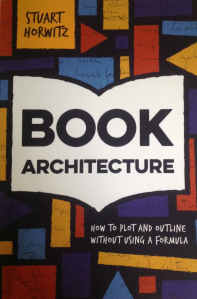
Stuart Horwitz is also a ghostwriter, independent developmental editor. He developed the Book Architecture Method (www.BookArchitecture.com) over fifteen years of helping writers get from first draft to final draft. His first book, Blueprint Your Best Seller: Organize and Revise Any Manuscript with the Book Architecture Method (Penguin/Perigee) was named one of the best books about writing by The Writer magazine.
Save
Filed under: Ask the Expert, Editors, Experts, Guest posts, Kimberly Kurth Gray, Recommended Reads, The Detective's Daughter Tagged: Book Architect, stuart Horwitz, writing

July 13, 2016
Wicked Wednesday: Myth Busting Part 1
There are so many myths and rules that fly around about writing and the writing process that we decided to tackle some of them head on. Bust them, actually. Because the truth is, if something works–or doesn’t work–for you, then you have to honor that. We’re all different people and we all approach the craft of writing differently. It’s a learning process, for sure. And the way to jump in isn’t with other people’s rules front and center, halting your creative process.
This week, we’re sticking with the character theme and talking about character bibles. Many people say you must have one, and it has to have specific elements to be effective. So Wickeds, what do you think? Do you use character bibles? Does having or not having one make or break your books?
Edith: I have one for each series. I need a list of all the characters and what I know about  them. While writing book three in a series, for example, I can’t remember what kind of car a secondary character drove in book one, what color that guy’s eyes are, or what year my protag was born. If I couldn’t go back and check my Series Characters folder, I would waste a lot of time searching through the manuscripts of prior books. I’d also start repeating names or using names like James and Jamie in the same book, which is too confusing. I don’t always know all the information in the bible at first, though. When I discover something new about a character, I go and add it, so the file grows bigger all the time. And of course the entry for my protagonist (see the red circle) is by far the longest, because I know the most about her.
them. While writing book three in a series, for example, I can’t remember what kind of car a secondary character drove in book one, what color that guy’s eyes are, or what year my protag was born. If I couldn’t go back and check my Series Characters folder, I would waste a lot of time searching through the manuscripts of prior books. I’d also start repeating names or using names like James and Jamie in the same book, which is too confusing. I don’t always know all the information in the bible at first, though. When I discover something new about a character, I go and add it, so the file grows bigger all the time. And of course the entry for my protagonist (see the red circle) is by far the longest, because I know the most about her.
Liz: This is one area where I wish I was more organized! I don’t subscribe to rules in general, but this is common sense – and I wish I had started a character bible at the beginning of this series. Now every time I finish a book and have wasted time combing through prior manuscripts for details, I declare that I’ll start one. And then I start it and don’t finish. For my new series, I swear I’ll do it differently!
 Barb: I don’t keep character bibles in any prospective way. I don’t do bios or interview my characters in advance. But I do keep character bibles retrospectively. A part of cleaning up and shutting down every manuscript includes going through the text and copying and pasting character details I don’t want to forget into the character pages in Scrivener. I won’t say I’ve succeeded 100%. I’ve still had to scramble back through manuscripts for details I neglected to record. (Last one, did I ever tell you the first name of Julia’s father?) But it works pretty well.
Barb: I don’t keep character bibles in any prospective way. I don’t do bios or interview my characters in advance. But I do keep character bibles retrospectively. A part of cleaning up and shutting down every manuscript includes going through the text and copying and pasting character details I don’t want to forget into the character pages in Scrivener. I won’t say I’ve succeeded 100%. I’ve still had to scramble back through manuscripts for details I neglected to record. (Last one, did I ever tell you the first name of Julia’s father?) But it works pretty well.
Sherry: I don’t keep a character bible either. I do have lists of characters that my Kensington copy editor has sent. And I do end up using the search function on word to search for character descriptions and traits that I’ve used before. I should probably start copying those tidbits into a file one of these days!
Julie: I use Scrivener’s character pages, and setting pages. For each new book, copy all those files over to the new document. When I add details, I add them there. I have found that my characters and settings get more details as the series progresses, and that is alright. As the writer, I just need to stay a couple of steps ahead of the reader, and remember what the details I’ve added are. I would LOVE to find a mapping software so I could create a 3D Orchard. That’s the hardest part for me.
Save
Filed under: Wicked Wednesday Tagged: character bible, characters, myth busting, writing process

July 12, 2016
Lesson of the Knuckleball by guest Naomi Hirahara
Julie here, thrilled to welcome Naomi Hirahara to the blog today. Her Mas Arai mystery series features a Japanese American gardener and atomic-bomb survivor who solves crimes. In this, the sixth book of the series, Naomi uses the lens of baseball to tell the story. A perfect summer read. Thanks for visiting the blog Naomi!
************************************************************
By Naomi Hirahara
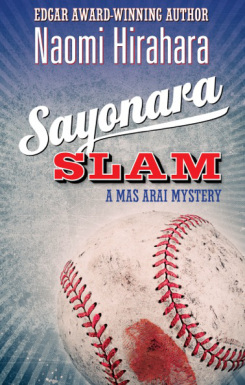 Growing up, I was the ultimate nerd girl. I wore skirts that my mother got from my grandmother in Japan. I was usually the one of the shortest students in the class; dodge ball was my personal nightmare as I was targeted first for the sting of the ball. But then in sixth grade something happened. I started playing basketball for a community league.
Growing up, I was the ultimate nerd girl. I wore skirts that my mother got from my grandmother in Japan. I was usually the one of the shortest students in the class; dodge ball was my personal nightmare as I was targeted first for the sting of the ball. But then in sixth grade something happened. I started playing basketball for a community league.
I couldn’t block shots or rebound that well. But I discovered that I could dribble or more importantly, steal balls from my opponent. Pretty soon, the girls from the other team sitting on the bench would yell out, “Watch out,” when I got in position to play defense. I had found my niche. Be fast and quick. And be tenacious.
Ever since that time, I’ve loved sports. I love the underdog stories, the stories of men and women who have overcome big odds – whether it be emotional, mental, financial, social or even physical – to excel in sports. Teammates who bond together and cheer on the weakest player, because that’s the only way the team can win sometimes. I’m also fascinated by the celebrity of sports – how athletes can challenge societal norms and expectations.
In my latest Mas Arai novel, Sayonara Slam, I examine the relations between Korea and Japan through the lens of baseball at Dodger Stadium. But the story is much more than even that – baseball has played a role in the Japanese American experience ever since Babe Ruth and other stars went on a barnstorming tour of Japan in the 1934. And then there is the phenomenon of Eri Yoshida, the first woman to be drafted by a Japanese professional baseball team at age 16. She also became the first woman to play professionally in two countries – Japan and the US.
Yoshida is a knuckleball pitcher. Anyone who knows baseball is aware that the knuckleball pitchers are a rare breed. These pitchers don’t have to rely on brute strength and power to be effective. No, they depend on a certain je ne sais quoi that some observers unfairly put in the category of circus performers.
There are only two knuckleball pitchers on Major League Baseball teams today: Steven Wright on the Boston Red Sox (see, I worked in New England!) and R.A. Dickey for the Toronto Blue Jays. Since I’ve featured a Japanese female knuckleball pitcher in Sayonara Slam, I did my share of research. I watched a fabulous documentary called, “Knuckleball!”, and read Dickey’s autobiography, Wherever I Wind Up. Dickey’s story is especially compelling because he was a highly touted pitcher in high school and college but later discovered that he was missing a ligament in his right elbow joint during a medical exam for a professional baseball team. His baseball career looked like it was over until he decided to embrace the knuckleball.
Someone like Eri Yoshida, a woman who stands 5’1”, can also play on a men’s professional baseball team with the magic of the knuckleball. After a brief stint of playing minor league baseball in California and Hawaii, Yoshida is still pitching at age 24 for a men’s semipro team, the Ishikawa Million Stars, in Japan. Watch Yoshida in action here:
It was a joy to write about America’s oldest pastime in my latest mystery. Truth be told, I’m more of a basketball fan. But the lesson of the knuckleball – for the underdog to surprise – is something that I continue to hold close to my heart, not only in sports but also in writing and life.
When you feel down and out, find your knuckleball!
Naomi Hirahara is the Edgar Award-winning author of the Mas Arai and Officer Ellie Rush series.
Filed under: Guest posts Tagged: baseball, Dodgers, knuckleballs, Naomi Hirahara, Sayonara Slam



